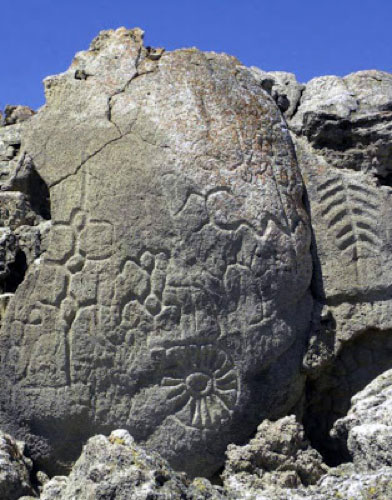Scientists now say that the petroglyphs at Pyramid Lake, Nevada, are the oldest in North America to have been age-dated. Though appearing confident about some details, they cannot yet identify the ancient peoples who carved those rocks. But the ancients did possess one characteristic that surprised secular scientists.
Lying inside a Paiute Reservation, the Nevada petroglyphs look well-crafted and aesthetic. Diamond-like patterns resembling fish scales and tight, regular designs, including shallow cup forms, adorn limestone boulders. The carvings also look similar to petroglyphs that U.S. Bureau of Land Management archaeologist William Cannon discovered at Long Lake in Oregon and described to Nevada State Museum’s Eugene Hattori.
Hattori coauthored a study on petroglyphs at both sites, published in the Journal of Archaeological Science.1 He explained to Mail.com, “We initially thought people 12,000 or 10,000 years ago were primitive, but their artistic expressions and technological expertise associated with these paints a much different picture.”2
 Not only was his idea of primitive ancients wrong, it’s likely his age assignments are wrong, too.3
Not only was his idea of primitive ancients wrong, it’s likely his age assignments are wrong, too.3
Secularists regularly express surprise over the advanced skills of these supposedly primitive people. But their surprise hinges on the purely imaginative idea that some kind of ape underwent a gradual transformation as it evolved toward humankind. This long process would have produced primitive, ape-like people (or people-like apes) who could have littered the globe with over two million years’ worth of juvenile rock graffiti. Where is the archaeological evidence of this transitional creature?
Instead, the markings of even the earliest peoples are consistent with the creation hypothesis that people have always been people. After all, God made man in His image.
Secularists have shown surprise at finding well-formed artifacts all over the globe, like the world’s oldest temple in Turkey. Its carvings included anatomically accurate animals and easily recognizable people.4 Ice-Age Germans mass produced spears, and Stone Age men decorated baskets in South Africa.5,6 Ancient American petroglyphs now add to the list of surprisingly well-formed artifacts. Whoever carved them was clearly already “advanced.”
References
- Benson, L.V., E.M. Hattori, J. Southon, and B. Aleck. Dating North America’s oldest petroglyphs, Winnemucca Lake subbasin, Nevada. Journal of Archaeological Science. 40 (12): 4466-4476.
- Nevada petroglyphs the oldest in North America. Mail.com. Posted on mail.com August 14, 2013, accessed August 19, 2013.
- The team carbon dated material beneath the glyphs as well as patina on their surface to derive their dates. But “carbon years” higher than just a few thousand are notoriously older than calendar years. See: Baumgardner, J. 2003. Carbon Dating Undercuts Evolution's Long Ages. Acts & Facts. 32 (10). See also: Thomas, B. North America’s Oldest Inhabitants Found in Texas. Creation Science Update. Posted on icr.org April 5, 2011, accessed August 21, 2013.
- Thomas, B. Oldest Temple Topples Evolutionists’ History of Religion. Creation Science Update. Posted on icr.org January 12, 2012, accessed August 20, 2013.
- Thomas, B. Eight Spears Found in German Coal Mine. Creation Science Update. Posted on icr.org October 8, 2012, accessed August 20, 2013.
- Thomas, B. 2011. Identifying Neandertal Man. Acts & Facts. 40 (3): 18.
Image credit: AP
* Mr. Thomas is Science Writer at the Institute for Creation Research.
Article posted on August 23, 2013.













